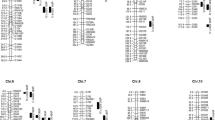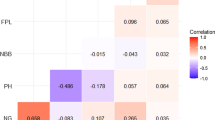Abstract
The genetic basis of heterosis in rice was studied in a cross between Zhenshan 97 and Minghui 63, the parents of the best hybrid widely used in rice production in China. Field data for yield and yield components traits were collected over two years from 240 F2:3 families of this cross planted in replicated field trials. These families were assayed with 151 marker loci that were polymorphic between the parents and a linkage map was constructed with Mapmaker analysis. A total of 32 quantitative trait loci (QTLs) were identified for yield and the three component traits: 12 QTLs were detected in both years and the remaining 20 QTLs were observed in only one year. A search for the entire genome by using two-way analyses of variance with all possible two-locus combinations detected a very large number of significant digenic interactions involving both the QTLs resolved by single-locus analysis and loci that did not show significant effects by single-locus analysis. Many of the interactions were simultaneously detected in both years. Partitioning of the epistatic interactions recovered all three types of interactions, i. e. additive by additive, additive by dominance and dominance by dominance, for all the traits. Some of the epistatic interactions even showed pleiotropic effects by simultaneously affecting two or more traits. The results clearly indicate that epistasis plays a significant role in the inheritance of yield traits as well as in the genetic basis of heterosis.
Similar content being viewed by others
References
Bruce, A. B., The Mendelian theory of heredity and augmentation of vigor,Science, 1910, 32: 627.
Shull, G. H., The composition of a field of maize.Am. Breed Assoc., 1908, 4: 298.
East, E. M., Heterosis,Gentics, 1936, 21: 375.
Stuber, C. W., Lincoln, S. E., Wolff, D. W. et al., Identification of genetic factors contributing to heterosis in a hybrid from two elite maize inbred lines using molecular markers,Genetics, 1992, 132: 823.
Mitchell-Olds, T., Interval mapping of viability loci causing heterosis in Arabidopsis,Genetics, 1995, 140: 1105.
Xiao, J., Li, J., Yuan, L. et al., Dominance is the major genetic basis in rice as revealed by QTL analysis using molecular markers,Genetics, 1995, 140: 745.
Wright, S.,Evolution and Genetics of Populations, Vol. 1, Chicago: Univ. Chicago Press, 1968.
Allard, R. W., Genetic basis of the evolution of adaptedness in plants,Euphytica. 1996, 92: 1.
Rieseberg, L. H., Sinervo, B., Linder, C. R. et al., Role of gene interactions in hybrid speciation: evidence from ancient and experimental hybrids,Science. 1996, 272: 741.
Li, Z., Pinson, S. R. M., Park, W. D. et al., Epistasis for three grain yield components in rice (Oryza sativa L.).Genetics, 1997, 145: 453.
Yu, S. B., Li, J. X., Xu, C. G. et al., Importance of epistasis as the genetic basis of heterosis in an elite rice hybrid.Proc. Natl. Acad. Sci. USA. 1997, 94: 9226.
Liu, K. D., Wang, J., Li, H. B. et al., A genome-wide analysis of wide compatibility in rice and the precise location of the S5 locus in the molecular map,Theor. Appl. Genet., 1997, 95: 809.
Wu, K. S., Tanksley, S. D., Abundance polymorphism and genetic mapping of microsatellites in rice,Mol. Gn. Genet., 1993, 241: 225.
Knapp, S. J., Stroup, W. W., Ross, W. M., Exact confidence intervals for heritability on a progeny mean basis,Crop Sci., 1985, 25: 192.
Lincoln, S., Daly, M., Lander, E.,Constructing Genetics Maps With MAPMAKER/EXP3.0, Cambridge: Whitehead Institute Technical Report, 1992a.
Manly, K., Codmore, R., Kohler. G.,A Program for Genetic Mapping of Mendelian and Quantiative Trait Loci, Springer-Verlag: New York Inc., 1994.
Lincoln, S., Daly, M., Lander, E.,Mapping Genes Controlling Quantitative Traits With MAPMAKER/QTL1 - 1, Cambridge: Whitehead Institute Technical Report, 1992b.
Snedecor, G. W., Cochran, W. G.,Statistical Methods, Ames: Iowa Stare Univ. Press, 1980.
StatSoft Inc.,Statistica, Tusla: StatSoft Inc., 1991.
Cause, M. A., Fulton, T. M., Cho, Y. G. et al., Saturated molecular map of the rice genome based on en interspecific backcross population.Genetics, 1994, 138: 1251.
Kurata, N., Nagamura, Y., Yammoto, K. et al., A 300 kilobase inteva1 genetic map of rice including 883 expreessed sequences.Nature Genetics, 1994, 8: 365.
Author information
Authors and Affiliations
Additional information
Project supported by the National Natural Science Foundation of China (Grant No. 39525014) and the Rockefeller Foundation.
Rights and permissions
About this article
Cite this article
Yu, S., Li, J., Xu, C. et al. Epistasis plays an important role as genetic basis of heterosis in rice. Sci. China Ser. C.-Life Sci. 41, 293–302 (1998). https://doi.org/10.1007/BF02895105
Received:
Issue Date:
DOI: https://doi.org/10.1007/BF02895105




